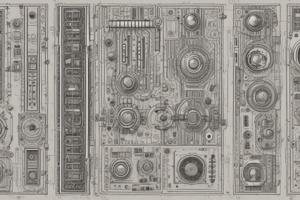Podcast
Questions and Answers
Why is a four to 20 milliamp current used for analog inputs instead of zero to 20 milliamps?
Why is a four to 20 milliamp current used for analog inputs instead of zero to 20 milliamps?
- Zero to 20 milliamps is too sensitive for most sensors.
- Four to 20 milliamps allows for a zero reading to indicate a broken wire, while a full tank is represented by 20 milliamps. (correct)
- Four to 20 milliamps provides a greater range for the sensor output.
- Four to 20 milliamps is the standard industry practice and ensures compatibility between different devices.
What is the role of the transmitter in an analog input system?
What is the role of the transmitter in an analog input system?
- The transmitter filters the analog signal from the sensor.
- The transmitter amplifies the analog signal from the sensor.
- The transmitter converts the digital signal from the sensor to an analog signal.
- The transmitter converts the analog signal from the sensor to a digital signal. (correct)
What is the primary function of the analog input controller card?
What is the primary function of the analog input controller card?
- To convert the analog signal from the sensor to a digital signal. (correct)
- To filter the analog signal from the sensor.
- To control the flow of current to the sensor.
- To amplify the analog signal from the sensor.
What does the digital value obtained from the analog input controller card represent?
What does the digital value obtained from the analog input controller card represent?
In the context of analog inputs, what is meant by 'sampling'?
In the context of analog inputs, what is meant by 'sampling'?
Which of the following is NOT a typical example of an analog input device?
Which of the following is NOT a typical example of an analog input device?
What is the significance of the 'offset' in the four to 20 milliamp current range used for analog inputs?
What is the significance of the 'offset' in the four to 20 milliamp current range used for analog inputs?
What is the primary benefit of using analog input devices in control systems?
What is the primary benefit of using analog input devices in control systems?
What is the primary reason for calibrating a pressure transmitter with a slightly negative pressure range?
What is the primary reason for calibrating a pressure transmitter with a slightly negative pressure range?
What is the purpose of the pneumatic tubing connecting the pressure transmitter to the tank?
What is the purpose of the pneumatic tubing connecting the pressure transmitter to the tank?
In the given scenario, what is the approximate pressure reading at the halfway point of the tank?
In the given scenario, what is the approximate pressure reading at the halfway point of the tank?
What is the total pressure range of the pressure transmitter mentioned in the content?
What is the total pressure range of the pressure transmitter mentioned in the content?
Why is the statement "I'm not suggesting that a tank would ever get as high as 25 psi inside the tank" included in the content?
Why is the statement "I'm not suggesting that a tank would ever get as high as 25 psi inside the tank" included in the content?
What type of input is the pressure transmitter considered in the context of the content?
What type of input is the pressure transmitter considered in the context of the content?
What current is expected to be measured on the cables when the tank is empty?
What current is expected to be measured on the cables when the tank is empty?
If the tank is 50% full, what is the corresponding current on the cable?
If the tank is 50% full, what is the corresponding current on the cable?
What is the highest digital value that can be represented by a 12-bit A to D converter?
What is the highest digital value that can be represented by a 12-bit A to D converter?
What is the binary equivalent of the range in values for a 16-bit A to D converter?
What is the binary equivalent of the range in values for a 16-bit A to D converter?
What digital value would represent a 50% full tank in the memory address of a 12-bit controller?
What digital value would represent a 50% full tank in the memory address of a 12-bit controller?
What needs to be calibrated to display tank levels in % full instead of digital values like 2048?
What needs to be calibrated to display tank levels in % full instead of digital values like 2048?
Why might an operator struggle to make decisions with a digital value like 2048 displayed?
Why might an operator struggle to make decisions with a digital value like 2048 displayed?
What is required to convert a digital value to an engineering unit for operator use?
What is required to convert a digital value to an engineering unit for operator use?
What does the scaling factor inside the analog input card depend on?
What does the scaling factor inside the analog input card depend on?
What is the role of the PLC programmer in relation to digital values?
What is the role of the PLC programmer in relation to digital values?
Study Notes
Analog Inputs Overview
- Analog inputs differ from digital inputs, requiring sampling of continuously changing signals rather than simple binary states.
- Example of an analog input includes monitoring temperature or tank levels.
Current Transmission
- Analog input devices, such as level meters, transmit a current signal of 4 to 20 milliamps.
- The minimum value is set to 4 mA to avoid misreading a zero signal due to wire damage or corrosion, indicating an empty tank's baseline as 4 mA instead of 0 mA.
Signal Measurement
- Analog input cards sample current signals through a 12-bit or 16-bit Analog-to-Digital (A/D) conversion process.
- 12-bit conversion results in 4096 possible values (from 0 to 4095), while 16-bit conversion allows for 65,536 values.
Example of Tank Level Measurement
- For a tank, 4 mA indicates it is empty, while 20 mA signals it is full.
- A tank filled to half (50 feet of a 100-foot tank) would send a current reading of 12 mA.
- The corresponding memory register value for half-full in a 12-bit system would be approximately 2048.
Operator Interface
- Operators typically need intuitive representations, such as percentages, instead of raw digital values like 2048.
- PLC programmers convert A/D values into understandable engineering units for operator assessment.
Scaling and Calibration
- Proper scaling is essential for translating raw values into physical engineering units.
- A scaling formula incorporates low and high ranges of measurement to determine real-world values.
Pressure Measurement Example
- Pressure transmitters can calibrate from a slight negative pressure (e.g., -5 psi) to a positive maximum (e.g., 25 psi).
- A pressure reading halfway through this range, calculated using the scaling formula, would likely be 10 psi.
Practical Implications
- Understanding these analog inputs is critical for decision-making in operations requiring real-time monitoring of varying physical parameters.
Studying That Suits You
Use AI to generate personalized quizzes and flashcards to suit your learning preferences.
Description
This quiz covers the concepts of analog inputs, sampling and digital representation of changing values over time, such as temperature, in digital systems.




